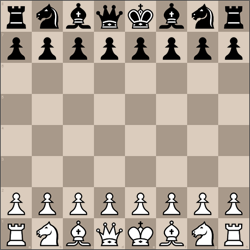February 23 1919
The Philadelphia Inquirer, Chess, Philadelphia, Pennsylvania, Sunday, February 23, 1919
In the latter part of 1918 Stasch Mlotkowski, a strong Philadelphia player, now residing at Los Angeles, played in two interesting events. In the Los Angeles Tournament he tied with E. R. Perry for first place and in the play-off defeated Perry with a score of two wins, one loss and three drawn games. The following game is one of the contest.
(a) Black could have played B-Q2 Q-N3 or Q-R4ch, but played the text under, the impression that he would get sufficient attack by his next move in reply to PxP to compensate for the break up of the position on the Queen's side.
(b) Well played, in fact, the saving move, as B-N5ch was threatened.
(c) White again chooses the best move. 12. P-K4 BxP; 13. Q-Q2 NxR; 14. Q-K3 looked tempting, but would be answered by NxP with advantage to Black.
(d) White might have played 15. P-B7 QxP; (if Q-R5; R-R2 and, the Knight is still imprisoned); 16. N-N6 Q-Q1; (best) 17. NxR KxB; 18. BxP and now P-N4 could be replied to with Q-N4ch, K-N1; B-Q6.
(e) White threatened Q-N7. The text is to prevent this and give Black's Knight a chance to develop at R3 if White does not continue as in the actual game. P-N4 would have been answered by NxP, PxB; N-R6 dis ch, K-R1: NxB, RxN; Q-N7.
(f) White could have safely continued with P-Q5, as Black could not play R-N7ch, K-N3 and take Pawn either Rook or Bishop. However, the move made is also a good one, as if the Pawn is not taken it will hold Black from making full use of his forces, and if it is White gets a winning end game.
(g) R-K1 should have been played, holding back the King's Pawn. After the text move, Black's game is lost. This seems to indicate White should have played 26. P-K4.
(h) Not a good move on general principles.
(i) P-Q5ch would have won more quickly.
(j) If now P-Q5ch, Black would play BxP and draw.
(k) K-Q6 was somewhat quicker.
(l) B-R6; K-N6; K-B1 would have made it more difficult. White could then win by P-B7, B-Q2; K-B5, B-R5, P-K6; P-K7, B-B2: K-B6, B-K1ch; K-Q5 and bringing the King over to KB8.
Everett Robbins Perry (white) vs. Stasch Mlotkowski (black)
Queen's Gambit Accepted
Submitted to chessgames.com on 5/09/2025
April 06 1919
The Philadelphia Inquirer, Chess, Philadelphia, Pennsylvania, Sunday, April 06, 1919
The following game was forwarded to us by Stasch Mlotkowski, of Los Angeles, Cal. Mlotkowski's method of handling the Petroff Defense will be found of interest.
Elmer W. Gruer (white) vs. Stasch Mlotkowski (black)
Russian Game: Classical Attack, Marshall Variation
Submitted to chessgames.com on 05/09/2025
5W--As we have heretofore mentioned N-QB3 is well worth playing. If Black captures the Knight, then White replies QPxN and by Castling on the Queen's side can develop a strong attack against Black King's wing, as Black practically will be forced to Castle on the King's side.
6B--We believe that B-K2 is Black's strongest continuation.
8B--Marshall states that he now prefers to continue with 8. Castles and if White continues with 9. PxP, then Black plays P-KB4, followed by N-Q2, etc.
13W--White, of course, could not play RxP on account of the reply N-B3.
15B--Mlotkowski's comments on this game states that he preferred to give up the Knight's Pawn rather than defend it, as then his King's wing could be weakened by White continuing with N-N5, etc.
June 08 1919
The Philadelphia Inquirer, Chess, Philadelphia, Pennsylvania, Sunday, June 08, 1919
The game given below was played last summer at Los Angeles, Cal., in the Championship Tournament. The announced mate in six moves is well worth examining.
(a) A conservative form of the Giuoco Piano. White plays his fifth move in anticipation of Black Castling and later starting a King side attack.
(b) N-QB3 was the more natural continuation, to be followed by B-Q2, should Black pin the Queen's Knight.
(c) Mlotkowski considers this move weak, as it puts his Queen out of play and leaves the Queen's Pawn without support.
(d) An error of judgment as Black can reply NxBP; 21. NxN QxQ; 22. PxQ PxN, etc, nevertheless the win is not easy.
(e) Likely the best continuation. See previous note.
(f) This move does not improve matters. However, White's game appears hopelessly compromised.
(g) The mate is accomplished as follows: 28. RxPch; 29. K-Ksq N-B7ch; 30. K-Q2 K-K6ch; 31. KxN QxRch; 32. K-N3 Q-K4ch, followed by R-Rsq. mate.
W. A. Lewis (white) vs. Stasch Mlotkowski (black)
Italian Game: Giuoco Pianissimo
Submitted to chessgames.com on 05/11/2025
The two-move problem is an original composition by Mlotkowski never before published. Mlotkowski states that the problem was suggested by the four-hand round tournament, but does not comply with the conditions there stated of separate mates for every block, as the Knights are used to answer both the Rook and Bishop moves. However, more variety is obtained in this way, the threat having seven defenses, five illustrating Black interferences and two self blocks.
White to play and mate in two moves.
FEN Q4K1B/2Pp1R2/RN1nk3/2p3p1/2p1r1p1/4b2N/3r1p2/8 w - - 0 1
Solution: 1. Qd8 Nxf7 2. Qf6#























